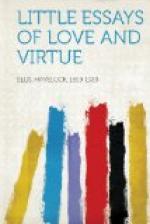So it is that the problem of the attitude of the child to its parents circles round again to that of the parents to the child. The wise parent realises that childhood is simply a preparation for the free activities of later life, that the parents exist in order to equip children for life and not to shelter and protect them from the world into which they must be cast. Education, whatever else it should or should not be, must be an inoculation against the poisons of life and an adequate equipment in knowledge and skill for meeting the chances of life. Beyond that, and no doubt in the largest part, it is a natural growth and takes place of itself.
CHAPTER II
THE MEANING OF PURITY
I
We live in a world in which, as we nowadays begin to realise, we find two antagonistic streams of traditional platitude concerning the question of sexual purity, both flowing from the far past.
The people who embody one of these streams of tradition, basing themselves on old-fashioned physiology, assume, though they may not always assert, that the sexual products are excretions, to be dealt with summarily like other excretions. That is an ancient view and it was accepted by such wise philosophers of old times as Montaigne and Sir Thomas More. It had, moreover, the hearty support of so eminent a theological authority as Luther, who on this ground preached early marriage to men and women alike. It is still a popular view, sometimes expressed in the crudest terms, and often by people who, not following Luther’s example, use it to defend prostitution, though they generally exclude women from its operation, as a sex to whom it fails to apply and by whom it is not required.
But on the other hand we have another stream of platitude. On this side there is usually little attempt either to deny or to affirm the theory of the opposing party, though they would contradict its conclusions. Their theory, if they have one, would usually seem to be that sexual activity is a response to stimulation from without or from within, so that if there is no stimulation there will be no sexual manifestation. They would preach, they tell us, a strenuous ideal; they would set up a wholesome dictate of hygiene. The formula put forward on this basis usually runs: Continence is not only harmless but beneficial. It is a formula which, in one form or another, has received apparently enthusiastic approval in many quarters, even from distinguished physicians. We need not be surprised. A proposition so large and general is not easy to deny, and is still more difficult to reverse; therefore it proves welcome to the people—especially the people occupying public and professional positions—who wish to find the path of least resistance, under pressure of a vigorous section of public opinion. Yet in its vagueness the proposition is a little disingenuous; it condescends to no definitions and no qualifications; it fails even to make clear how it is to be reconciled with any enthusiastic approval of marriage, for if continence is beautiful how can marriage make it cease to be so?




